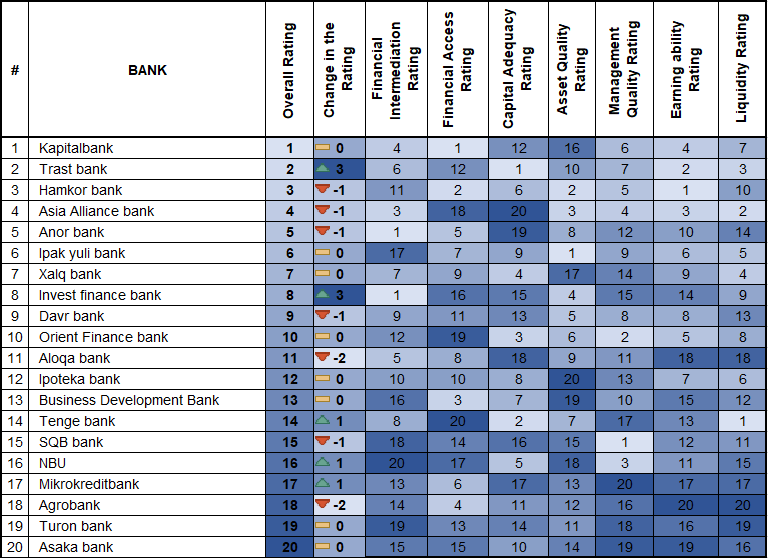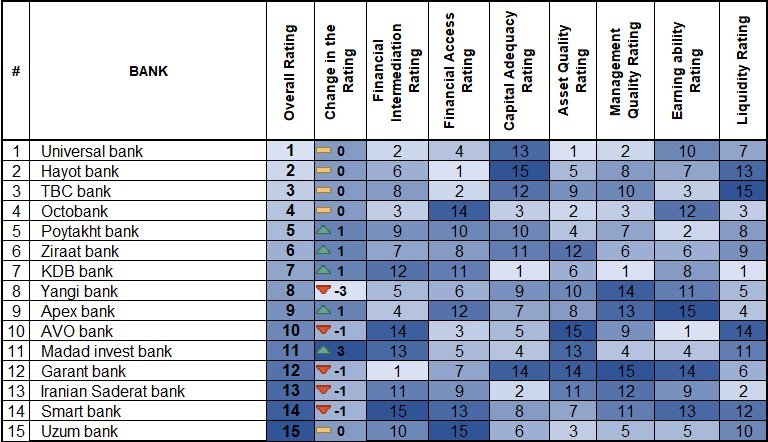CERR has updated the Bank Activity Index for the Q2, 2025, covering 35 commercial banks operating in Uzbekistan. The Index accounts for the classification of banks into two groups: 20 large and 15 small institutions.
Since 2021, the Bank Activity Index has been calculated by CERR to evaluate transformation processes within the banking sector and the effectiveness of measures aimed at increasing transparency and outreach. The methodology is based on 27 indicators, grouped into seven key dimensions, including financial inclusion, financial intermediation, return on assets and loan portfolio quality, profitability, management efficiency, liquidity, and asset quality.
The Index reflects both the operational and structural aspects of banking performance and evaluates banks’ activity in the market environment. The consolidated ranking demonstrates the current standings of banks based on a comprehensive evaluation across all sub-indices.
As of the first half of 2025, the total assets of Uzbekistan’s banking system grew by 21% year-on-year. This growth, however, varies across bank categories. State-owned banks increased their assets by an average of 17%, with the most notable growth observed at Aloqabank (39%) and Mikrokreditbank (36%).
Growth was more pronounced among private banks, where aggregate assets rose by 28%, driven in part by new market entrants such as Hayot Bank (419%), Smart Bank (233%), and Yangi Bank (223%), reflecting the dynamics typical of early-stage scaling.
Large Bank Activity Ranking for Q2 2025
At the end of the first half of 2025, Kapitalbank maintained its leadership, remaining at the top of the ranking. Trastbank showed the most dynamic performance, climbing three positions to claim second place. Hamkorbank and Asia Alliance Bank secured third and fourth positions, respectively. Anor Bank, which entered the large banks category, ranked fifth, despite dropping one position.

Invest Finance Bank advanced three positions to rank eighth. Tenge Bank and NBU each improved by one position, reaching 14th and 16th place, respectively. At the same time, one-third of large banks experienced a decline in their rankings. Davr Bank and Uzpromstroybank (SQB) each dropped by one position, while Aloqabank and Agrobank fell by two positions each. Other banks retained their positions, indicating increasing competition across key performance dimensions.
In terms of financial intermediation (i.e., the ratio of deposits to loans and obligations to other banks and the state), the steepest decline was seen at Ipak Yuli Bank, which fell six positions, potentially reflecting weakened lending activity.
The financial inclusion indicator, which evaluates the number of clients per branch, loan portfolio concentration, and private sector lending, also impacted several banks. Ipoteka Bank dropped three positions, while Anor Bank and Agrobank each lost two, and Ipak Yuli Bank and Asaka Bank dropped by one position.
Under the asset quality criterion, based on return on assets (ROA) and the share of non-performing loans, Ipoteka Bank remained at the bottom. Significant declines were also recorded for Davr Bank (down 4 positions), Kapitalbank and Anor Bank (down 2 each), and Asaka Bank (down 1).
Agrobank ranked 20th in the profitability index. Additional declines were observed at Tenge Bank and Anor Bank, both of which dropped two positions.
Mikrokreditbank remains at the bottom in management efficiency. Negative dynamics were also noted for BDB (down 3 positions), Aloqabank (down 2), and four other commercial banks that lost one position each.
In the liquidity sub-index, several large banks saw a drop. Agrobank fell three positions and ranked last. Anor Bank showed a sharper decline — down five positions. Kapitalbank, Trastbank, and Hamkorbank each lost two positions in this area. In contrast, Uzpromstroybank improved by five positions.
Small Bank Activity Ranking for Q2 2025
Among small banks, Universal Bank, Hayot Bank, TBC Bank, and Oktobank maintained their positions in the top four, demonstrating the resilience of their operational models amid market volatility and competitive pressure.

One-third of small banks improved their performance compared to the previous quarter. Madad Invest Bank showed the most improvement, climbing three positions to rank 11th.
Meanwhile, five banks demonstrated a negative trend. The most notable decline in performance was seen at Yangi Bank, reflecting a weakening of operational indicators.
The results of the updated Bank Activity Rating reveal growing competition among both large and small banks in Uzbekistan. Monitoring these indicators remains a critical tool for assessing the resilience and progress of the financial sector.
Banking and Financial Sector Research Sector
Tel: (78) 150 02 02 (ext. 441)























leave a comment